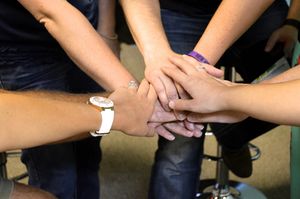EDN
- We build the new authenticated p2p-based Internet.
Welcome
This is the official wiki of the research and software project EDN (Echt Dezentrales Netz - real decentralized network). Our vision is to provide a more secure and confidentiality preserving communication means to billions of people: individuals, families and organisations of whatever format - a new internet fitted with a set of privacy tuned services running on local individual or public infrastructure via copper, WiFi, Bluetooth, etc that meets our standard.
News
We have presented EDN to the people of Wau Holland Foundation recently. Thank you for your invitation!:)
Here is our project diary.
- Note
- .onion addresses can be accessed via Tor Browser Bundle
Status Quo
The Internet Is Broken
Today's communication infrastructure is predominantly centralized. That starts with all digital communication of one country going through one or just a few telecommunication providers' server.
On these metadata are accumulating - the base to derive people's social graphs, movement patterns and even psychological profiles. The contents of their calls are computable since they are not end-to-end-encrypted.
Peoples' wish to reach as many people possible for communication has led to a focus on using certain services that had good usability qualities - known as the Network Effect.
This has let grow services like Facebook, Twitter or Youtube significantly and also to big data congregations at relatively few points. Those data congregations awaken greediness, since it has among other market value.
To make things worse DNS (Domain Name System) and BGP routing (Border Gateway Protocol) - some basic internet protocols (!) - are vulnerable to a number of attacks which open ways to undermine even (!) overlaying structures such as Tor, deanomizing its users and hidden services by traffic correlation.
These conditions faciliate:
- Censorship: On plattforms and by countries;
- Passive Mass Spying;
- Active Intrusion on a global scale;
It is most likely that patches like overlay networks can only ease the shortcommings of the current internet but not fix it using this vulnerable basis for confidental communication.
Threat Model
We presume a global active attacker that does automated intrusion such as traffic shaping. We draw the line before targeted operations. We share our threat model with Secushare.
Privacy Software Projects

We found over 80 Free Software Privacy Projects and this is nowhere near complete regarding that. All compete for contributors, funding, users, bandwith while implementing redundant, often mediocre solutions which is no wonder since most of them lack ressources to do it all good. This leads to bad code documentation which consequently impedes potential help by new developers or researchers finding vulnerabilities and providing more secure solutions. And this maybe of course a crucial reason why there is nearly no collaboration between the projects although (!) they share the same goals. Having the projects share code or even collaborate to reach more than a single project could do, would help saving ressources and enbetter the chances to focus on usability and hard problems such as providing good privacy and security to their users. Making its usage a comforting experience on the other hand is a crucial point to let a project fly and gain the critical user mass for the Network Effect which on the other hand is crucial for achieving a good amount of anonymity. This is what we aim at by conducting the Software Documentation Marathon. This will eventually lead to easy usable more secure and privacy preserving communication tools. Since the internet is broken, we want to go even further. The new internet stacks among these projects call for having services on top of them running and evaluated. This is what we aim at in the Prototyping and Testing phase.
Goal

Regarding the design flaws of the current internet, we believe that a complete new internet providing confidentiality, integrity of communication and censorship-resistance natively is indispensable. We aim to build it and envision the new stack to be
- Privacy tuned for and delivered with several services
- Convenient and attractive to use
- Able to run on local individual and public infrastructure
- Free Software
The new internet uses the existing infrastructure to form a difficult-to-monitor cellphone/router/computer network. Its communication runs, first and foremost, on top of a combination of WiFi, copper and fibre optics, but we also consider Bluetooth, Ultra Wideband (UWB), red light, ukw and satellite uplinks - shortly all allowed frequencies and ways.
I. Privacy and Security Criteria
The new internet should meet the following criteria as good as possible. The quality of security and privacy might vary between the different exposed services. (...).
Services
| public | personal/private | ||
|---|---|---|---|
| Text | Chat of local (neighboring) nodes | To a single person: Chat, Email or SMS | To multiple people: Chat or mailing list |
| Audio/Telephony/Video | Call among locally restricted nodes | normal call | conference call |
| Other formats | ? | ? | ? |
- Social-Networking: Messaging, (Video)-Telephonie, File-sharing, Blogging
- Searching contents in local and other reachable networks
- Crypto Currency/ Pay System
Beneficiaries of the new internet
In long term everyone will benefit from the new internet. Since it is censorship resistant and provides confidentiality and integrity preserving services, it results in:
- Average citizens regaining parts of their privacy, informational self determination, freedom of assembly, secrecy of correspondence and free speech- basic civil rights that ensure and back up our democracies.
- Safer government institutions and companies from espionage and "cyber" attacks.
Use cases are for example online banking, government communication with citizens including tax returns, diplomatic and business communication and journalism.
Approach

We aim to unite the different forces and resources for privacy and security such as the older and upcoming software projects, scientists, activists and others to achieve what none of them could do alone: Provide a more secure and confidentiality preserving communication means to a significant part of the world-population - a new internet fitted with a set of privacy tuned services. To get there we built bridges by creating a better documentation for over 70 privacy projects during our Software Documentation Marathon™. It will include a first analysis of the project's security and privacy qualities and recommendations for collaborations between interoperable projects. On this basis we are able to proceed with a Prototypical Realisation and evaluation of new internet stacks with services on top of them.
Software Documentation Marathon
We plan a Software Documentation Marathon™, where we document and analyze over 70 Privacy Software Projects. Key elements of our work will be to assemble detailed API descriptions of the projects and its modules and to identify and highlight Interoperability between projects for collaboration or sharing code. (...).
Prototyping and Testing
Find this chapter here.
Best Current Practice Recommendation
The following is an essence of a Best Current Practice Recommendation.
-
Instant Messaging: Ricochet
-
Filesharing: Tribler
-
Asynchronous Messaging: Bitmessage
We add this one:
Browsing: Tor-Browser-Bundle
Costs
Find our calculations here.
Community and Crew
We are stakeholders of GNU consensus and allies of the #youbroketheinternet project. To our crew belong software architects, a student of Fine Arts, Privacy Project developers and Privacy and Security researchers.
Contact
Be with us!
Write us in Bitmessage:
BM-NBqqoMzajZNXQru2Kz4JXqq6RbsEmeuL
Email: demos et posteo dot de, GPG, Fingerprint:
9A0E 7D84 0D22 F15A 3FE3 4756 2DB7 1A63 B093 2843




